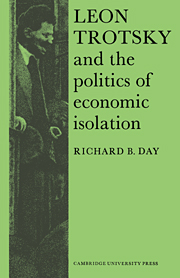Book contents
- Frontmatter
- Contents
- Preface
- Part one THE DILEMMA OF ECONOMIC ISOLATION
- 1 The myth of Trotskyism
- 2 Isolation and the mobilization of labour
- 3 Integrationism and the New Economy Policy
- Part two THE POLITICS OF ECONOMIC ISOLATION
- Bibliography
- Notes
- Index
- CENTRE FOR RUSSIAN AND EAST EUROPEAN STUDIES UNIVERSITY OF TORONTO
2 - Isolation and the mobilization of labour
Published online by Cambridge University Press: 25 October 2009
- Frontmatter
- Contents
- Preface
- Part one THE DILEMMA OF ECONOMIC ISOLATION
- 1 The myth of Trotskyism
- 2 Isolation and the mobilization of labour
- 3 Integrationism and the New Economy Policy
- Part two THE POLITICS OF ECONOMIC ISOLATION
- Bibliography
- Notes
- Index
- CENTRE FOR RUSSIAN AND EAST EUROPEAN STUDIES UNIVERSITY OF TORONTO
Summary
Early in the Great War Imperial Russia fell victim to an almost total economic blockade. German armies severed direct communications with Europe, leaving only the remote ports of Vladivostok on the Pacific and Archangel on the White sea as points of contact with the Allies. Unprepared for hostilities, the government failed to prevent a steady economic deterioration. Unprecedented demands for military transport caused frequent breakdowns; and scarce supplies, both military and civilian, were often impossible to move by 1916. Reductions in the movement of consumer goods to the countryside were matched by dwindling grain shipments to the cities. Hunger riots and industrial strikes followed. The replacement of the monarchy by the Provisional Government in March 1917 intensified the paralysis.
In November 1917 the Bolsheviks seized power. Lenin and his followers were moved by an unrealistic confidence both in the international proletariat and in their own ability to formulate successful policies as the need arose. Beginning with the simple faith that socialism would somehow arise of its own accord from the ruins of capitalism, the revolution shortly passed from a festival of anarchy to a period of authoritarian economic controls. The civil war brought with it a steadily widening gap between traditional socialist ideals and economic necessity. Within little more than two years a pattern of organization emerged which in many ways provided a prototype for Stalin's five-year plans of the 1930s. Ironically the main architect of this system was Trotsky.
Information
- Type
- Chapter
- Information
- Leon Trotsky and the Politics of Economic Isolation , pp. 17 - 46Publisher: Cambridge University PressPrint publication year: 1973
